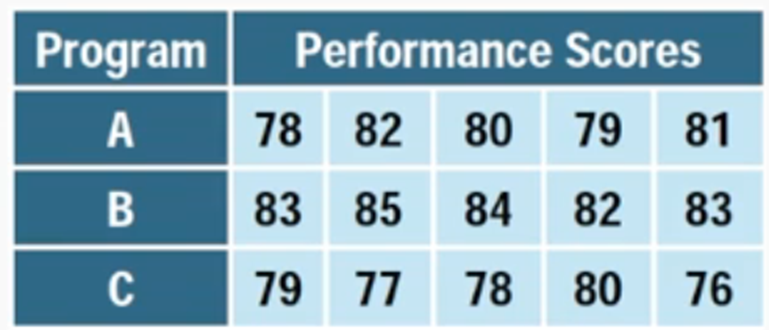A school administrator wants to examine whether students' academic performance differs based on the type of instructional method used in their classes. A random sample of students is selected and divided evenly among the three teaching methods. After a semester, all students take the same standardized final exam. State the null and alternative hypotheses for a one-way ANOVA test.
Table of contents
- 1. Introduction to Statistics53m
- 2. Describing Data with Tables and Graphs2h 1m
- 3. Describing Data Numerically2h 8m
- 4. Probability2h 26m
- 5. Binomial Distribution & Discrete Random Variables3h 28m
- 6. Normal Distribution & Continuous Random Variables2h 21m
- 7. Sampling Distributions & Confidence Intervals: Mean3h 37m
- Sampling Distribution of the Sample Mean and Central Limit Theorem19m
- Distribution of Sample Mean - Excel23m
- Introduction to Confidence Intervals22m
- Confidence Intervals for Population Mean1h 26m
- Determining the Minimum Sample Size Required12m
- Finding Probabilities and T Critical Values - Excel28m
- Confidence Intervals for Population Means - Excel25m
- 8. Sampling Distributions & Confidence Intervals: Proportion1h 33m
- 9. Hypothesis Testing for One Sample3h 32m
- 10. Hypothesis Testing for Two Samples4h 49m
- Two Proportions1h 12m
- Two Proportions Hypothesis Test - Excel28m
- Two Means - Unknown, Unequal Variance1h 2m
- Two Means - Unknown Variances Hypothesis Test - Excel12m
- Two Means - Unknown, Equal Variance15m
- Two Means - Unknown, Equal Variances Hypothesis Test - Excel9m
- Two Means - Known Variance12m
- Two Means - Sigma Known Hypothesis Test - Excel21m
- Two Means - Matched Pairs (Dependent Samples)42m
- Matched Pairs Hypothesis Test - Excel12m
- 11. Correlation1h 24m
- 12. Regression1h 59m
- 13. Chi-Square Tests & Goodness of Fit2h 31m
- 14. ANOVA2h 1m
14. ANOVA
Introduction to ANOVA
Struggling with Statistics for Business?
Join thousands of students who trust us to help them ace their exams!Watch the first videoMultiple Choice
A regional sales director wants to determine whether different customer service training programs lead to different levels of employee performance across three branches. Each branch uses one of the following training programs: Program A. Program B, or Program C. After one month, the director measures the performance score (out of 100) for 5 randomly selected employees from each branch. Using α=0.05, perform a one-way ANOVA to determine whether there is a statistically significant difference in mean performance among the three training programs.

A
Since the performance scores for all three programs (A, B, and C) range from 76 to 85, there is no statistically significant difference between the training programs.
B
The P-value from the one-way ANOVA is greater than 0.05, so we fail to reject the null hypothesis and conclude that the type of training program does not affect employee performance.
C
The P-value from the one-way ANOVA is less than 0.05, so we reject the and suggest .
D
The one-way ANOVA is inappropriate for this study because it compares two groups only, a different statistical test should be used.
 Verified step by step guidance
Verified step by step guidance1
Step 1: Define the null hypothesis (H₀) and the alternative hypothesis (Hₐ). H₀: The mean performance scores are the same across all three training programs (Program A, Program B, and Program C). Hₐ: At least one training program has a different mean performance score.
Step 2: Calculate the group means for each training program. For Program A, calculate the mean of the scores {78, 82, 80, 79, 81}. For Program B, calculate the mean of the scores {83, 85, 84, 82, 83}. For Program C, calculate the mean of the scores {79, 77, 78, 80, 76}.
Step 3: Compute the overall mean (grand mean) by averaging all the performance scores across the three programs. Add all the scores together and divide by the total number of scores (15).
Step 4: Calculate the between-group sum of squares (SSB) and the within-group sum of squares (SSW). SSB measures the variation between the group means and the grand mean, while SSW measures the variation within each group. Use the formulas: SSB = Σnᵢ(μᵢ - μ)² and SSW = ΣΣ(xᵢⱼ - μᵢ)², where nᵢ is the number of observations in group i, μᵢ is the mean of group i, μ is the grand mean, and xᵢⱼ is an individual observation.
Step 5: Perform the one-way ANOVA test by calculating the F-statistic using the formula F = (SSB / df_between) / (SSW / df_within), where df_between = k - 1 (number of groups minus 1) and df_within = N - k (total number of observations minus number of groups). Compare the calculated F-statistic to the critical F-value at α = 0.05 or use the P-value to determine whether to reject or fail to reject the null hypothesis.

 6:46m
6:46mWatch next
Master Introduction to ANOVA with a bite sized video explanation from Patrick
Start learningRelated Videos
Related Practice
Multiple Choice
Introduction to ANOVA practice set


